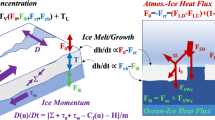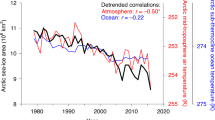Abstract
A MARKED discontinuity in the sea surface temperature with horizontal gradients up to 1° C km−1 is often observed in the western Irish Sea during the summer. This feature is the boundary between stratified and vertically mixed regimes1. Here we describe observations by airborne radiation thermometer (ART) and conventional methods, and suggest a simple model accounting for the observed form and stable position of the front.
This is a preview of subscription content, access via your institution
Access options
Subscribe to this journal
Receive 51 print issues and online access
$199.00 per year
only $3.90 per issue
Buy this article
- Purchase on Springer Link
- Instant access to full article PDF
Prices may be subject to local taxes which are calculated during checkout
Similar content being viewed by others
References
Simpson, J. H., Deep-Sea Res., 18, 309 (1971).
Hunter, J. R., thesis University College of North Wales, Bangor (1972).
Bowden, K. F., The Physical Oceanography of the Irish Sea, Fish. Invest., Series II, XVIII, No. 8 (1955).
Author information
Authors and Affiliations
Rights and permissions
About this article
Cite this article
SIMPSON, J., HUNTER, J. Fronts in the Irish Sea. Nature 250, 404–406 (1974). https://doi.org/10.1038/250404a0
Received:
Revised:
Issue Date:
DOI: https://doi.org/10.1038/250404a0
This article is cited by
-
Rain triggers seasonal stratification in a temperate shelf sea
Nature Communications (2023)
-
Stratification and temporal evolution of mixing regimes in diurnally heated river flows
Environmental Fluid Mechanics (2023)
-
Interannual variability and mechanism of ocean stratification over the Kuroshio Extension region in the warm season
Climate Dynamics (2023)
-
Characteristics and influencing factors of frontal upwelling in the Yellow Sea in summer
Acta Oceanologica Sinica (2022)
-
Phytoplankton taxonomic and functional diversity patterns across a coastal tidal front
Scientific Reports (2021)
Comments
By submitting a comment you agree to abide by our Terms and Community Guidelines. If you find something abusive or that does not comply with our terms or guidelines please flag it as inappropriate.



